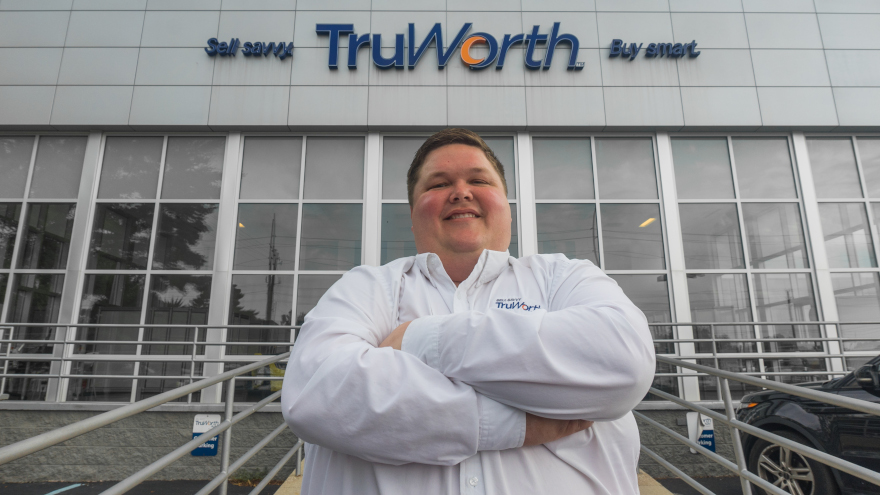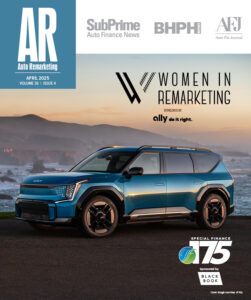Alternative sourcing redefining inventory planning for car dealers

Nick Hardwick, general manager for TruWorth Auto’s Kokomo, Ind., independent dealership. Photo courtesy of store.
The numbers foretell how dramatic inventory planning must change if dealers want to keep their used-car lots filled.
Decreasing new-car sales, declining lease originations and consumers keeping vehicles longer are together tightening the supply of used cars. New-car dealers feel the pinch, and so too do independent and buy-here/pay-here (BHPH) operators.
Some say the car business now is more about acquiring the right cars from the right sources than about selling them.
Increasingly, dealers must rely on sourcing more inventory from private parties and trade-ins, and by stocking “alternative” vehicles to the “A-listers” in tight supply, advised Ed French, president of AutoProfit Automotive Consulting.
The tightening used-car supply — buffeted by decreasing new-car sales, declining lease originations and many consumers keeping vehicles on the road longer — means new-car, independent and buy-here/pay-have to look harder for the used cars they need.
J.D. Power/LMC projected a 2018 seasonally adjusted SAAR of 16.1 million to 17.1 million units. The lower of the two forecasts would place SAAR at early 2014 levels. For now, used-car sales remain brisk and are expected to continue, the firm said.
However, the Cox Automotive 2018 Used Car Market Report and Outlook reported vehicles aged 6 to 10 years old are in short supply.
IHS Markit 2016 data noted the average age of light trucks and cars is increasing, to 11.6 years, up 0.2 years since 2014. A news release on that data, released in November 2016, also noted trends.
“The shifting dynamic of the age of vehicles in operation indicates the volumes of vehicles in the new to 5-years-old category will grow 16 percent by 2021, while vehicles in the 6- to 11-year-old range will grow just 5 percent, and vehicles that are 12-plus years old will grow 10 percent. The oldest vehicles on the road are growing the fastest — with vehicles 16 years and older expected to grow 30 percent from 62 million units today to 81 million units in 2021. More than 20 million vehicles on the road in 2021 will be more than 25 years old,” IHS Markit reported.
Online search engine and research firm iSeeCars.com recently said that most new vehicles are traded or otherwise sold after 7.4 years.
iSeeCars.com’s most recent 2018 data also highlighted how long some new car owners keep their vehicles. The company analyzed more than 6 million used vehicles sold by original owners to identify which models are kept the longest. The average for the top 10 models, said communications manager Julie Blackley, ranges from 8.3 to 9 years or nearly 11 percent and 21 percent longer than average, respectively.
The data noted SUVs accounted for five of the top 10 listings, with the Corvette, a minivan, and three sedans rounding out the list. In descending length of ownership, the five SUVs are Ford Expedition, 9 years; Toyota Sequoia, 8.9 years; Toyota 4Runner, 8.8 years; Ford Explorer, 8.4 years; and Chevrolet Suburban, 8.4 years. A related study by iseecars.com indicated that long-held large SUVs are the vehicles most likely to roll up 200,000 or more.
Reasons consumers keep SUVs longer are probably apparent. All vehicles today are built better than in prior years, including mechanical and components as well as their protection against body panel corrosion. Body-on-frame construction for SUVs gives them truck-like durability, Blackley noted, and because of their size, families tend to hang onto them as family haulers.
Another insight, from March 2018 Experian data, noted that model years 2007 to 2013 represented 31.1 percent of the 272 million cars on the road.
While many cars will present with higher mileage — and iSeeCars.com says 2.4 percent will have more than 200,000 miles, mostly SUVs as noted — they are also the bread-and-butter for many independents’ and buy-here/pay-here dealers.
The numbers also show why dealers are having to forgo acquiring some makes and models they’d prefer to stock and instead need to pursue what French defines as Alternative B and C options.
“If I can buy a Santa Fe or other alternative B car with a higher content level than the Explorer my customers would prefer I stock, can I get them to consider this other make and model that might, after all, be hundreds if not thousands of dollars less than the Ford?” French said.
“Every dealer is in this situation, and if owners are keeping their Explorer 8.4 years all dealers are suffering,” he said.
With everyone scrambling for the same-sized buy, those with deeper pockets and better acquisition strategies are best suited to come out winners.
“The franchise dealers have a built-in trade network, but for the independents sourcing inventory getting cars is getting tougher. It’s not necessarily that there are not enough cars, but not enough makes and models consumers want to buy,” French said. “All dealers now have to source inventory from private parties.”
Doing so is a two-dealership operator, TruWorth Auto, with stores in Indianapolis and Kokomo, Ind. French is a member of the organization’s board of directors. TruWorth started operations in 2011. The stores retail 120 units a month and inventory a mix of 3- to 8-year-old vehicles having under 120,000 miles on their odometers.
“Our goal is to source 60 to 70 percent of our inventory from off the street or trade-ins,” said Nick Hardwick, general manager for TruWorth Auto’s Kokomo, Ind., independent dealership. Between this and TruWorth’s Indianapolis location, the dealership retails 120 units a month.
“Last month we bought 87 vehicles off the street and took in 45 in trade, and we acquire about 20 or so units using online auction services,” Hardwick said.
Private-party and alternative inventory sourcing aren’t new strategies, but dealers must rely on these channels more and more. French advised all dealers to create internal sourcing-buying centers that focus on non-auction sources for fresh inventory.
“These are folks that work all day long to buy cars,” French said.
That’s the philosophy used at TruWorth Auto, though its sourcing centers are its people, Hardwick said. “This idea is ingrained in our culture. Staff is compensated for buying and selling and when that’s your focus you get good at both.”
The dealership also uses a variety of third-party digital tools for sourcing private-party leads — “and we use old school personal networking too,” Hardwick added.

 View The Latest Edition
View The Latest Edition

